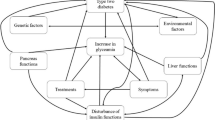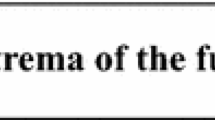Abstract
Global comparisons of learning from hypertext/hypermedia and traditional presentation formats like text have yet failed to show major advantages concerning the effectiveness of hypermedia learning. Thus, it is proposed in the current paper to evaluate hypermedia environments more specifically with regard to their potential to implement and support well-defined learning approaches. According to this view, an effective hypermedia design needs to be based on thorough cognitive task analyses with regard to structures, processes, and resources that are required to benefit from a specific learning approach. This claim is illustrated by two experiments in which we explored the instructional potential of hypermedia environments for improving schema acquisition from worked-out examples. A cognitive task analysis was used to identify specific types of information comparisons that are crucial for successful schema induction and that might be effectively supported by suitably designed hypermedia environments. The experiments investigated two methods for enhancing comparison processes in hypermedia-assisted learning from worked-out examples, namely, elaboration prompts and an interactive comparison tool. Both methods improved performance for near-transfer problems. Ways of extending this task-analytical approach to facilitating far transfer are also discussed.



Similar content being viewed by others
References
Atkinson, R. K., Derry, S. J., Renkl, A., & Wortham, D. W. (2000). Learning from examples: Instructional principles from the worked examples research. Review of Educational Research, 70, 181–214.
Azevedo, R. (2005). Using hypermedia as a metacognitive tool for enhancing student learning? The role of self-regulated learning. Educational Psychologist, 40, 199–209.
Beasley, R. E., & Waugh, M. L. (1996). The effects of content-structure focusing on learner structural knowledge acquisition, retention, and disorientation in a hypermedia environment. Journal of Research on Computing in Education, 28, 271–281.
Bernardo, A. B. I. (1994). Problem-specific information and the development of problem-type schemata. Journal of Experimental Psychology: Learning, Memory, and Cognition, 20, 379–395.
Catrambone, R. (1998). The subgoal learning model: Creating better examples to improve transfer to novel problems. Journal of Experimental Psychology: General, 127, 355–376.
Chen, C., & Rada, R. (1996). Interacting with hypertext: A meta-analysis of experimental studies. Human-Computer Interaction, 11, 125–156.
Chi, M. T. H., Bassok, M., Lewis, M. W., Reimann, P., & Glaser, R. (1989). Self-explanations: How students study and use examples in learning to solve problems. Cognitive Science, 13, 145–182.
Conati, C., & VanLehn, K. (2000). Toward computer-based support of meta-cognitive skills: A computational framework to coach self-explanation. International Journal of Artificial Intelligence in Education, 11, 389–415.
Conklin, J. (1987). Hypertext: An introduction and survey. Computer, 20, 17–41.
Cooper, G., & Sweller, J. (1987). Effects of schema acquisition and rule automation on mathematical problem-solving transfer. Journal of Educational Psychology, 79, 347–362.
Cummins, D. D. (1992). Role of analogical reasoning in the induction of problem categories. Journal of Experimental Psychology: Learning, Memory, and Cognition, 18, 1103–1124.
Cunningham, D. J., Duffy, T. M., & Knuth, R. A. (1993). The textbook of the future. In C. McKnight, A. Dillon, & J. Richardson (Eds.), Hypertext: A psychological perspective (pp. 19–49). New York: Ellis Horwood.
Derry, S. J. (1989). Strategy and expertise in solving word problems. In C. B. McCormick, G. Miller, & M. Pressley (Eds.), Cognitive strategy research: From basic research to educational applications (pp. 269–302). New York: Springer.
Dias, P., Gomes, M. J., & Correia, A. P. (1999). Disorientation in hypermedia environments: Mechanisms to support navigation. Journal of Educational Computing Research, 20, 93–117.
Dillon, A. (1996). Myths, misconceptions, and an alternative perspective on information usage and the electronic medium. In J.-F. Rouet, J. J. Levonen, A. Dillon, & R. J. Spiro (Eds.), Hypertext and cognition (pp. 25–42). Mahwah, NJ: Erlbaum.
Dillon, A., & Gabbard, R. (1998). Hypermedia as an educational technology: A review of the quantitative research literature on learner comprehension, control, and style. Review of Educational Research, 68, 322–349.
Edwards, D., & Hardman, L. (1989). ‘Lost in hyperspace’: Cognitive mapping, navigation in a hypertext environment. In R. McAleese (Ed.), Hypertext: Theory into practice (pp. 105–125). Oxford: Intellect Books.
Gerjets, P. H., & Hesse, F. W. (2004). When are powerful learning environments effective? The role of learning activities and of students” conceptions of educational technology. International Journal of Educational Research, 41, 445–465.
Gerjets, P., Scheiter, K., & Tack, W. H. (2000). Resource-adaptive selection of strategies in learning from worked-out examples. In L. R. Gleitman & A. K. Joshi (Eds.), Proceedings of the 22nd Annual Conference from the Cognitive Science Society (pp. 166–171). Mahwah, NJ: Erlbaum.
Gick, M. L., & Holyoak, K. J. (1983). Schema induction and analogical transfer. Cognitive Psychology, 15, 1–38.
Jacobson, M. J. (1994). Issues in hypertext and hypermedia research: Toward a framework for linking theory-to-design. Journal of Educational Multimedia and Hypermedia, 3, 141–154.
Jacobson, M. J., & Archodidou, A. (2000). The design of hypermedia tools for learning: Fostering conceptual change and transfer of complex scientific knowledge. The Journal of the Learning Sciences, 9, 149–199.
Jacobson, M. J., Maouri, C., Mishra, P., & Kolar, C. (1996). Learning with hypertext learning environments: Theory, design, and research. Journal of Educational Multimedia and Hypermedia, 5, 239–281.
Jacobson, M. J., & Spiro, R. J. (1995). Hypertext learning environments, cognitive flexibility, and the transfer of complex knowledge: An empirical investigation. Journal of Educational Computing Research, 12, 301–333.
Kintsch, W. (1988). The use of knowledge in discourse processing: A construction integration model. Psychological Review, 95, 163–182.
Landow, G. (1992). Hypertext: The convergence of contemporary critical theory and technology. Baltimore, MD: Johns Hopkins University Press.
Lawless, K., & Brown, S. (1997). Multimedia learning environments: Issues of learner control and navigation. Instructional Science, 25, 117–131.
Mayes, T., Kibby, M., & Anderson, T. (1990). Learning about learning from hypertext. In D. H. Jonassen & H. Mandl (Eds.), Designing hypermedia for learning (pp. 227–250). Berlin: Springer.
McGuire, E. G. (1996). Knowledge representation and construction in hypermedia and environments. Telematics and Informatics, 14, 251–260.
Niederhauser, D. S., Reynolds, R. E., Salmen, D. J., & Skolmoski, P. (2000). The influence of cognitive load on learning from hypertext. Journal of Educational Computing Research, 23, 237–255.
Pirolli, P., & Recker, M. (1994). Learning and transfer in the domain of programming. Cognition and Instruction, 12, 235–275.
Quilici, J. L., & Mayer, R. E. (1996). Role of examples in how students learn to categorize statistics word problems. Journal of Educational Psychology, 88, 144–161.
Reed, S. K. (1999). Word problems: Research and curriculum reform. Mahwah, NJ: Erlbaum.
Reed, S. K. (2005). From research to practice and back: The Animation Tutor project. Educational Psychology Review, 17, 55–82.
Reed, S. K., & Bolstad, C. A. (1991). Use of examples and procedures in problem solving. Journal of Experimental Psychology: Learning, Memory, and Cognition, 17, 753–766.
Renkl, A. (1997). Learning from worked-out examples: A study on individual differences. Cognitive Science, 21, 1–29.
Ross, B. H. (1989). Distinguishing types of superficial similarities: Different effects on the access and use of earlier problems. Journal of Experimental Psychology: Learning, Memory, and Cognition, 15, 456–468.
Rouet, J.-F., & Levonen, J. J. (1996). Studying and learning with hypertext: Empirical studies and their implications. In J.-F. Rouet, J. Levonen, A. Dillon, & R. Spiro (Eds.), Hypertext and cognition (pp. 9–25). Mahwah, NJ: Erlbaum.
Rouet, J.-F., Levonen, J. J., Dillon, A., & Spiro, R. J. (Eds.) (1996). Hypertext and cognition. Mahwah, NJ: Erlbaum.
Scheiter, K. & Gerjets, P. (2005). When less is sometimes more: Optimal learning conditions are required for schema acquisition from multiple examples. In B. G. Bara, L. Barsalou, & M. Bucciarelli (Eds.), Proceedings of the 27th Annual Conference of the Cognitive Science Society (pp. 1943–1948). Mahwah, NJ: Erlbaum.
Scheiter, K. & Gerjets, P. (in press). Learner control in hypermedia environments. Educational Psychology Review.
Scheiter, K., Gerjets, P., & Catrambone, R. (2006a). Making the abstract concrete: Visualizing mathematical solution procedures. Computers in Human Behavior, 22, 9–26.
Scheiter, K, Gerjets, P. & Schuh, J. (2004). The impact of example comparisons on schema acquisition: Do learners really need multiple examples? In Y. B. Kafai, W. A. Sandoval, N. Enyedy, A. S. Nixon, & F. Herrera (Eds.), Proceedings of the 6th International Conference of the Learning Sciences (pp. 457–464). Mahwah, NJ: Erlbaum.
Scheiter, K., Gerjets, P., Schuh, J., & Catrambone, R. (2006b). The acquisition of problem-solving skills in Mathematics: How animations can aid understanding for structural problem features and solution procedures. Manuscript submitted for publication.
Scheiter, K., Gerjets, P., Vollmann, B., & Catrambone, R. (2006c). A methodological alternative to media comparison studies: Linking information utilization strategies and instructional approach in hypermedia learning. In R. Sun & N. Miyake (Eds.), Proceedings of the 28th Annual Conference of the Cognitive Science Society (pp. 2117–2122). Mahwah, NJ: Erlbaum.
Schuh, J., Gerjets, P., & Scheiter, K. (2005). Fostering the acquisition of transferable problem-solving knowledge with an interactive comparison tool and dynamic visualizations of solution procedures. In B. G. Bara, L. Barsalou, & M. Bucciarelli (Eds.), Proceedings of the 27th Annual Conference of the Cognitive Science Society (pp. 1973–1978). Mahwah, NJ: Erlbaum.
Shapiro, A., & Niederhauser, D. (2004). Learning from hypertext: Research issues and findings. In D. H. Jonassen (Ed.), Handbook of research on educational communications and technology (pp. 605–620). Mahwah, NJ: Erlbaum.
Spiro, R. J., & Jehng, J.-C. (1990). Cognitive flexibility and hypertext: Theory and technology for the nonlinear and multidimensional traversal of complex subject matter. In D. Nix & R. J. Spiro (Eds.), Cognition, education, and multimedia (pp. 163–205). Hillsdale, NJ: Erlbaum.
Sweller, J., van Merriënboer, J. J. G., & Paas, F. W. C. (1998). Cognitive architecture and instructional design. Educational Psychology Review, 10, 251–296.
Tergan, S. O. (1997). Conceptual and methodological shortcomings in hypertext/hypermedia design and research. Journal of Educational Computing Research, 16, 209–235.
VanLehn, K. (1989). Problem solving and cognitive skill acquisition. In M. I. Posner (Ed.), Foundations of cognitive science (pp. 527–579). Cambridge, MA: MIT Press.
Acknowledgement
The work reported in this paper was supported by the Deutsche Forschungsgemeinschaft (DFG).
Author information
Authors and Affiliations
Corresponding author
Rights and permissions
About this article
Cite this article
Gerjets, P., Scheiter, K. & Schuh, J. Information comparisons in example-based hypermedia environments: supporting learners with processing prompts and an interactive comparison tool. Education Tech Research Dev 56, 73–92 (2008). https://doi.org/10.1007/s11423-007-9068-z
Published:
Issue Date:
DOI: https://doi.org/10.1007/s11423-007-9068-z




